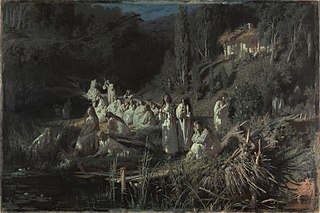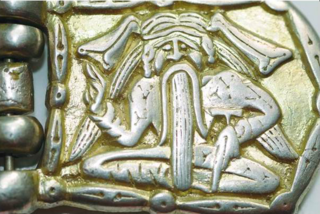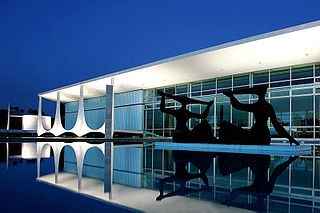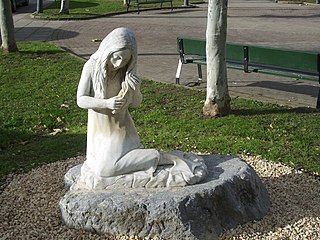| Turkic mythology |
|---|
 |
In Turkic mythology, a Susulu (Susuna or Susona) is a legendary aquatic creature with the upper body of a female human and the tail of a fish. Also known as Suna or Sona, she is the daughter of the Sea King. [1] [2]
| Turkic mythology |
|---|
 |
In Turkic mythology, a Susulu (Susuna or Susona) is a legendary aquatic creature with the upper body of a female human and the tail of a fish. Also known as Suna or Sona, she is the daughter of the Sea King. [1] [2]
Susulus appear in Turkic folklore as unlucky omens, both foretelling disaster and provoking it like mermaids. They are conventionally depicted as beautiful creatures with long flowing hair. They are said to inhabit lakes and rivers.
Susulus have also been described as able to swim up rivers to freshwater lakes. They are usually the ghosts of young women who died a violent or untimely death, perhaps by murder or suicide, and especially by drowning.
They appear as beautiful young women with long green hair and pale skin, suggesting a connection with floating weeds and days spent underwater in faint sunlight. They can be seen after dark, dancing together under the moon and calling out to young men by name, luring them to the water and drowning them.

The Nixie, Nixy, Nix, Näcken, Nicor, Nøkk, or Nøkken are humanoid, and often shapeshifting water spirits in Germanic mythology and folklore.

Merrow is a mermaid or merman in Irish folklore. The term is anglicised from the Irish word murúch.
Enchantress most commonly refers to:

Yuxa, or Yuha, is a legendary creature in Turkic mythology. According to popular beliefs, every 100-year-old snake is transformed into Yuxa. In fairy tales, Yuxa is described as a beautiful damsel who would marry men to beget offspring.

Brazilian mythology is the subset of Brazilian folklore with cultural elements of diverse origin found in Brazil, comprising folk tales, traditions, characters and beliefs regarding places, people, and entities. The category was originally restricted to indigenous elements, but has been extended to include:

In Slavic folklore, the rusalka is a female entity, often malicious toward mankind and frequently associated with water, it has counterparts in other parts of Europe, such as the French Melusine and the Germanic Nixie. Folklorists have proposed a variety of origins for the entity, including that they may originally stem from Slavic paganism, where they may have been seen as benevolent spirits. Rusalki appear in a variety of media in modern popular culture, particularly in Slavic language-speaking countries, where they frequently resemble the concept of the mermaid.
Pedro Penduko is a Filipino fictional comic book character created by National Artist for Literature Francisco V. Coching. The character, who is styled as a folk hero, debuted in the magazine Liwayway in 1954.

Hungarian mythology includes the myths, legends, folk tales, fairy tales and gods of the Hungarians.

Iara, also spelled Uiara, Yara or Hiara or Mãe das Águas, is a figure from Brazilian mythology based on Tupi and Guaraní mythology. The word derives from Nheengatu iiyara = ií ("water") + yara. Depending on the oral tradition and the context of the story, she can be seen either as a water nymph, a siren, or a beautiful mermaid that lives in the Amazon River.
The Sirena is a mythological sea creature from Filipino culture. Popular in folklore in many regions of the Philippines,In Philippine mythology, the Sirena is a mythological aquatic creature with the head and torso of a human female from waist down and the tail of a fish. The Sirena is an Engkanto –' the Filipino counterpart of English mermaids. Engkantos are classified as one of the Bantay Tubig, a Filipino term for mythical guardians of the water. In addition to the Sirena, other examples of Bantay Tubig are Siyokoy, Kataw, and Ugkoy. The male version of a Sirena is called a Sireno. Sometimes, Sirena are paired with Siyokoy. A popular mermaid character in the Philippines is Dyesebel.
A water spirit is a kind of supernatural being found in the folklore of many cultures:

The Mermaids is an 1871 oil on canvas by the Russian artist Ivan Kramskoi.

The lamia is a siren or nereid-like creature in Basque mythology. Lamiak are typically portrayed as living in and around rivers. They are depicted as beautiful, long-haired women with webbed duck feet, usually found at the river shore brushing their hair with a golden comb and seducing men.

In Turkic mythology, Su Iyesi is a water spirit. It corresponds to the nymph in Turkic cultures. It is a disembodied, incorporeal, intangible entity, but can turn into a male as well as a female creature who is the daughter of Yer Tanrı. Sometimes the master of water is depicted in the form of a bull.

Yel iyesi is the Turkic spirit or deity of wind. The name comes from the Turkic words "Yel," which means wind, and "iye," the familiar spirit of any natural asset.

In Turkic mythology, an Irshi is a type of mythical being or legendary fairy-like creature which is in a form of a spirit, often described as supernatural or preternatural.

Chai nenesi, is a name applied to Turkic spirits of water, commonly creeks. She is responsible for sucking people into swamps and lakes as well as killing the animals standing near the still waters.

Al Ana is a female fatal spirit or demon in Turkic folklore. Al Ana was said to live in thickets near rivers, streams and lakes.

In Slavic paganism there are a variety of female tutelary spirits associated with water. They have been compared to the Greek Nymphs, and they may be either white (beneficent) or black (maleficent). They may be called Navki, Rusalki, and Vily.